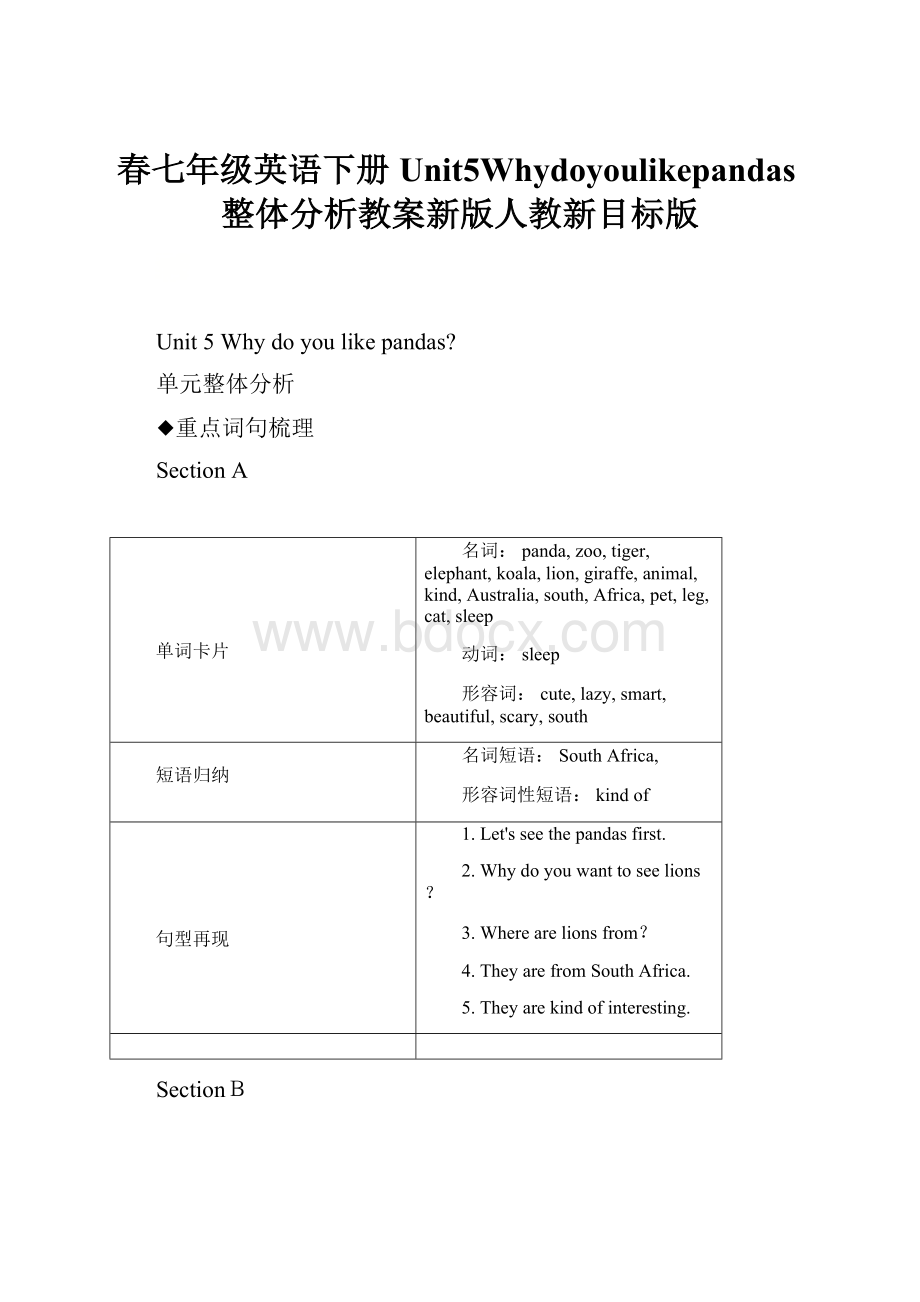春七年级英语下册Unit5Whydoyoulikepandas整体分析教案新版人教新目标版.docx
《春七年级英语下册Unit5Whydoyoulikepandas整体分析教案新版人教新目标版.docx》由会员分享,可在线阅读,更多相关《春七年级英语下册Unit5Whydoyoulikepandas整体分析教案新版人教新目标版.docx(16页珍藏版)》请在冰豆网上搜索。

春七年级英语下册Unit5Whydoyoulikepandas整体分析教案新版人教新目标版
Unit5Whydoyoulikepandas?
单元整体分析
◆重点词句梳理
SectionA
单词卡片
名词:
panda,zoo,tiger,elephant,koala,lion,giraffe,animal,kind,Australia,south,Africa,pet,leg,cat,sleep
动词:
sleep
形容词:
cute,lazy,smart,beautiful,scary,south
短语归纳
名词短语:
SouthAfrica,
形容词性短语:
kindof
句型再现
1.Let'sseethepandasfirst.
2.Whydoyouwanttoseelions?
3.Wherearelionsfrom?
4.TheyarefromSouthAfrica.
5.Theyarekindofinteresting.
SectionB
单词卡片
名词:
symbol,flag,place,water,danger,tree,ivory
动词:
save,forget,cut,kill
形容词:
friendly,shy
介词:
down,over
副词:
down
短语归纳
动词短语:
getlost,bein(great)danger,cutdown,bemadeof
句型再现
1.Thisisasymbolofgoodluck.
2.Elephantsareingreatdanger.
3.Wemustsavethetreesandnotbuythingsmadeofivory.
4.Ilikedogsbecausetheyarefriendlyandsmart.
5.TheelephantisoneofThailand'ssymbols.
◆教材内容解读
本单元以“动物园里的动物”为话题,用why,where引导的特殊疑问句及表示性质和品质的形容词谈论自己喜欢的动物以及它们生长的地方和习性。
SectionA部分通过设置参观动物园的情景,谈论动物及对动物的喜好,然后通过听、读、说活动学习谈论动物、喜好及产地。
SectionB部分通过对濒危动物的调查,引出保护濒危动物“大象”的语篇阅读,培养学生的保护动物的意识和人文素养,同时培养学生归纳中心与分析结构的阅读策略。
◆功能话题应用
Whatanimalsdoyoulike?
Ilikekoalas.
Whydoyoulikekoalas?
Becausethey’reverycute.
Wherearekpalasfrom?
They’refromAustralia.
◆语法结构点击
1.why引导的特殊疑问句的问与答。
2.表示性质和品质的形容词的用法。
背景知识链接
◆采用新教案P89话题相关链接。
SectionA
新课备课素材
◆素材一新课导入设计
导入一图片导入:
showsomepicturesaboutdifferentkindsofanimals;showthenewwordswiththepictures;thenleadtothenewlesson.
导入二游戏导入(Guessinggame):
Letastudentdescribeakindofanimals,otherSsguesswhatitis,likepandas,lion,elephantandsoon;thenleadtothenewlesson
导入三音乐导入:
“Enjoythemusic”,listentoOldMacdonaldhadafarm,andthenleadtothenewlesson.
◆素材二新课活动案例
活动1采用新教案P89活动设计:
活动一和活动二。
活动2Role-play(分角色表演,强化巩固以动物为话题的情景对话。
)
Step1Teachershowssomekeywordsandphrases;Ssusethemtomaketheirownconversationswithpartners.
Dogs,pandas,lions,elephants,cute,smart,lazy,beautiful,interesting,Australia,China,SouthAfrica
Step2学生自己提供有关单词,让其他小组进行现场对话练习。
◆素材三听说强化训练
采用P90听说训练。
◆素材四语法突破建议:
(一)【观察】1.Whydon’tyoulikeher?
【探究】Whydon’tyou+动词原形,还是一种提建议的句型。
意为“为什么不……呢?
”
e.gWhydon’tyoutakeawalkwithme?
你为什么不去散步呢?
(二)【观察】Well,becauseshe’skindofboring.
【探究】1.kindof有几分……相当于一个副词,后面多跟形容词。
e.gThey’rekindofscary.他们有点可怕。
Thepandasarekindofcute.熊猫有点可爱。
2.kind作名词意为“种类”
akindof…一种……
kind还可构成短语allkindsof...,意为“各种各样的”。
e.g.Iwanttobuyakindofdresslikeyours.我想买一条你那样的裙子。
Thisbookshophasallkindsofbooks.这家书店有各种各样的书。
(三)【观察】Let’sseethepandasfirst.
【探究】letsbdosth“让某人做某事”,可用来提出建议,也可表示“允许某人做某事”。
Let’sgotoschool!
让我们上学去吧!
新课教学典案
SectionAPeriod1(1a-1c)
Step1.Warming-upandleadin
Showstheclasssomepicturesofazoo.Andasksomequestionsaboutanimals:
T:
Doyouliketogotothezoo?
Doyoulikeanimals?
Thenhavethemtorecalltheanimalstheyknowandwritethemontheblackboardashe/shecan.
(e.g.animals---monkey,cat,dog,cow,duck…)
Step2.Presentation
1.Askthemtotalkwiththeirpartnersabouttheanimalstheylikeusingthewordstheyknow
—Whatanimalsdoyoulike?
—Whydoyoulike…
—Becausethey’re…
2.Thenshowtheclasssomepicturesofanimalsandpresentotheranimals.Andaskthem:
What’sthisinEnglish?
It'satiger.(Thenlion,panda,elephant,koala,giraffe)
Sslookatthepictureandtrytorememberthenewwordsoftheanimals.
3.Next,gluethepicturesontheblackboardandaskonestudenttomatchthepictureswiththewordsonthecards.Otherstudentsturntopage25andfinish1a.
4.Checktheanswerswiththeclass.
Step3.Game(Guessinggame.)
TShowsomepicturesonthebigscreen.LetSsguesswhatanimalitis.
Sstrytoguessandrememberthenamesoftheanimals.
Step4.Listening
Workon1b.
1.Listentothetapeandchecktheanimalstheyhearin1a.
Playtherecordingagainandchecktheanswerswiththeclass.
2.Listenandchoosetherightanswer.
(1).Whatarethegirl’sfavoriteanimals?
A.ThepandasB.ThetigersC.Thelions
(2).Whydoestheboywanttoseegiraffes.
A:
Becausetheyarecute.
B:
Becausetheyarebeautiful.
C:
Becausetheyareinteresting.
Step5.Pairwork
1.Askthestudentstoimagine“Weareinthezoo,therearemanykindsofanimalshere.”
Thenaskastudenttodothemodelwithyou:
—Let’sseethelionsfirst.
—Why?
(whydoyoulikelions?
)
—Becausetheyareinteresting.
3.Ssworkwiththeirpartnerspracticetheconversationusingtheanimalin1a.Thenactout.
Step6.Summaryandhomework.
SectionAPeriod2(2a-2d)
Step1.Warming-upandleadin.
1.Enjoythemusic:
listentoOldMacdonaldhadafarm.
2.Reviewthewordslearnedlastclass.
Step2.Listening
1.Workon2a;
(1).Listentotheconversationcarefully.Thenwritethenamesoftheanimalsyouhearontheselines.
Checktheanswers.
(2).Pointouttheadjectivesandcountrieslistedontheright.Askastudenttosaythewords.
Drawalinebetweeneachanimalandtheadjectiveandcountriesyouhear.
Playtherecordingandhavestudentsmatcheachanimalwithanadjectiveandacountry.
Correcttheanswers.
2.Workon2b
T:
Listenagainandcompletetheconversationwiththewordsin2a.
PlaytherecordingfortheSstolistenandwritetheanswers.
Checktheanswerswiththeclass.
Step3.Pairwork
1.Asktwostudentstoreadtheconversationin2btotheclass.
2.Sspracticetheconversationinpairs.
3.Thenshowthetranscriptiononthebigscreenandpracticetheothertwoconversationsin2a.
4.Sspracticetheconversationsinpairs.
Step4.Role-play
1.AskSstolookatthepicturein2d.ThenSsreadtheconversationin2dandfindtheanswerstothequestions:
①DoesPeterhaveapet?
②WhatcanDingdingdo?
③WhatpetdoesJenny’smomhave?
④DoesJennylikethecat?
Why?
2.Ssreadtheconversationsandtrytofindtheanswerstothequestions.
Checktheanswers:
Yes,hedoes.
Hecanwalkontwolegs.Hecandance,too.
Shehasacat.
No,shedoesn’t.Becauseit’sverylazy.
3.Ssworkinpairsandpracticetheconversation.
4.Letsomepairsrole-playtheconversation.
Step5.Languagepoints.
Step6.Homework:
1.Rememberthenewwordsandexpressionsinthisperiod.
2.Role-playtheconversationafterclass.
SectionAPeriod3(GrammarFocus-3c)
Step1.Warming-upandrevision
1.HaveadictationofthenewwordslearnedinPeriod1.
2.Letsomepairsrole-playtheconversationin2d.
Step2.GrammarFocus.
1.ReadGrammarFocusandunderstandthemeaningsofthesentences.
2.Readingtasks:
学生们合作学习讨论并总结why和because的用法。
Theteacherexplain“why”and“because”clearly.(见PPT)
3.GiveeightormoreminutesfortheSstorememberthesentences.
Step3.Practice
Workon3a
1.Lookat3a.Fillintheblankswiththewordsfromthebox.
2.Checktheanswers.
3.Practicetheconversation.
Workon3b.
1.TellSstowritethenamesofanimalsintheblankstomakesentencesthataretrueforyou.
e.g.
Ilikepandasbecausetheyareinteresting.
Ilikeelephantsbecausetheyaresmart.
Idon'tlikelionsbecausetheyarescary.
2.Ssworkingroups.Discussandwritetheirsentences.
3.LetsomeSsreporttheirlikesanddislikes.
Step4.Game(GuessingGame)
1.T:
Let'splayagame:
I'lldescribeoneanimaltoyou.Listencarefullyandthinkaboutwhatanimalitis.
2.TeachermakesamodeltotheSs.Sstrytoguesswhatanimalitis.
3.T:
It'syourturnnow.Pleasedescribeoneanimaltoyourgroupmembers.Letthemguesswhatanimalitis.
4.Ssworkingroups.Describeanimalsandguessanimals.
Step5.Exercises
Iftimeisenoughdosomemoreexercisesonthescreen.
Step6.Homework
1.ReadthesentencesinGrammarFocus.
2.Thinkanddescribeananimalafterclass.Thenwriteyoursentencesontheworkbook.
SectionB
新课备课素材
◆素材一新课导入方式参考
导入一图片导入:
Showsomeanimalpictures,andleadSstodescribetheseanimals.Thenleadtothenewlesson.(见PPT)
导入二复习导入:
创设场景,学生分角色表演,强化巩固以动物为话题的情景对话。
导入三视频导入:
通过看有关大象的视频,引入新课,调动课堂气氛,培养学生学习英语的兴趣。
(见PPT)
导入四Freetalk:
Talkabouttheanimalsyouknow.
◆素材二新课活动设计参考
采用新教案P96活动设计
◆素材三听说强化训练资料
采用P96听说训练。
◆素材四阅读突破建议
突破一任务教学2bFastreading:
Readthiswebsitearticleandcheckthebesttitleforit.
突破一任务教学2bCarefulreading:
Readthearticleagainandcompletethemindmap.
◆素材五语法突破建议:
(一)【观察】TheelephantisoneofThailand’ssymbols.
【探究】“oneof+名词复数”表示“……之一”。
当其作主语时,谓语动词使用第三人称单数形式。
e.g.:
Oneoftheboyswalkstoschooleveryday.
(二)【观察】Theycanalsorememberplaceswithfoodandwater.
【探究】with作介词,意为“有;具有;带有”,其反义词为without,意为“无;没有”
e.g.Iknowtheboywithalargebox.我认识那个提着大箱子的男孩。
【拓展】1.with意为“和……在一起;和;同”
e.g.Igototheparkwithmyparentseveryweekend.每个周末我都和父母去公园。
2.with意为“使用;以”
e.g.Pleasecuttheapplewithaknife.
(三)【观察】Isn’tshebeautiful?
【探究】词句为否定疑问句,表示反问:
“难道……不……吗?
”。
回答时,根据事实用Yes或No回答。
e.g.–Doesn’thehaveabrother?
“难道他没有一个兄弟吗?
”
--Yes,hedoes./No,hedoesn’t.“不,他有。
”/“是的,他没有。
”
SectionBPeriod1(1a-1d)
Step1.Warming-upandrevision
Checkthehomework.LetsomeSsreadouttheirdescriptionsandletotherSsguesswhatanimalitis.
Step2.Presentation
1.ShowsomepicturesonthebigscreenandteachSsthenewwords.
e.g.Showapictureofashygirl,letSsknowshe'sshy.
2.LetSsreadaloudthewordsandexpressions.
3.GiveSssometimeandreadaloudthewords.
4.
(1)Payattentiontotheanimalsinthepicturein1aandaskastudenttosaythenameofeachone.
(2).Pointoutthelistofeightnumberedadjectivesbelow.
Writet